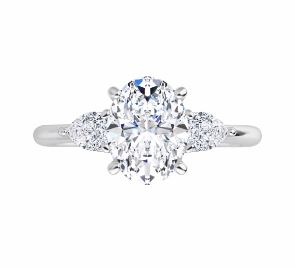5 Engagement Ring Myths
Posted on Wednesday, September 29th, 2021
in Engagement Rings.
Whether you know very little about engagement rings or consider yourself somewhat of an engagement ring expert, chances are you’ve heard one or more myths surrounding these fine jewelry baubles. Below, we’ll break down the five most common myths about engagement rings and explain why these myths are untrue.
Myth #1: Diamonds can’t break.
There’s a reason why diamonds are the most popular gemstone choice for engagement rings. Not only are diamonds beautiful, they’re also able to stand up to everyday wear. You may have heard that diamonds are the hardest gemstone on Earth. While that’s true, it doesn’t mean that a diamond is indestructible. All it takes to break a diamond is a hard hit in the correct place. Diamonds have certain areas, called cleavage planes, which when hit hard, can cause the diamond to chip or fracture. Some diamond shapes, like princess cut and pear are more susceptible to chipping due to their pointed edge(s). That’s why it’s so important to cover these sharp points properly with prongs.
Myth #2: All diamonds sparkle the same.
The cut of the diamond greatly affects its scintillation, or sparkle. For instance, a round, brilliant cut diamond will sparkle a lot more than an emerald or Asscher cut diamond. But even when you compare two diamonds of the same shape and cut, you may notice different levels of scintillation. All diamonds are individually cut, meaning that one diamond may not be cut as well as another. Diamonds that offer the most sparkle are the ones that are cut in a manner in which their proportions, symmetry, and polish allow the maximum amount of light to enter and leave the diamond. That’s why the cut of a diamond is one of the, if not the most important factors when determining the quality of a particular diamond.
Myth #3: Diamond florescence is bad.
Diamond florescence refers to the effect that ultraviolet light has on these gemstones. Some jewelry and gemstone experts believe that the presence of florescence can devalue a diamond while others believe that it actually enhances its appearance. The fact is that every diamond is unique, so the effect that fluorescence has on one diamond may be completely different from another. Diamonds that exhibit strong or very strong florescence can appear hazy or oily, which is the main reason why some people don’t like them. However, according to the Gemological Institute of America (GIA), less than 0.2% of florescent diamonds submitted to them exhibit this effect, so this is by no means a common problem among florescent diamonds. In fact, diamond florescence can actually make a lower color grade diamond appear more colorless, a trait commonly desired.
Myth #4: An engagement ring should cost three months’ salary.
This widely cited “rule” states that one should spend three months’ salary on an engagement ring. Originating from a 1930’s De Beers marketing campaign, men were advised to spend one month of their salary on an engagement ring. Several decades later, one month’s salary turned into two months’, and then three. The fact is you should spend whatever amount you feel comfortable spending on the ring. Take into consideration the type of ring your future fiancé will appreciate the most, set a budget, and work with an experienced jeweler to ensure you get the best ring possible within that budget.
Myth #5: You can find cheaper diamonds online.
While it’s true that you’ll likely find cheap diamonds online, it’s important to note that the actual value of these diamonds is often not worth the cost you pay. There’s a reason why the diamonds you see online are so cheap. Online diamond sellers often list lower-quality diamonds that smaller, locally owned jewelers have already rejected. And while you may think you’re getting a good deal on a particular diamond, you’ll also find that when you compare that diamond to another one of similar weight, color, and clarity, that the two diamonds may not be as similar as you initially thought. A diamond’s quality grade can tell you a lot about a particular diamond, but not everything. It doesn’t tell you how that diamond sparkles or how it looks in different types of light. When buying a diamond, you should always compare it in-person to similarly graded diamonds to get a better sense of which diamond is actually superior. And when you shop online, it’s no surprise that you won’t find the same level of service that you would at a local jewelry store. When you visit a jewelry store, the jeweler will take the time to really understand what you’re looking for. And once they’ve helped you pick out the best possible diamond in your budget, they’ll be there for you when you need any after-sales services, like ring resizing, polishing, and tightening of any gemstones.
Have any questions about engagement rings? Contact us at 414-276-2457 or info@kloiberjewelers.com. And view part of our engagement ring collection here.


